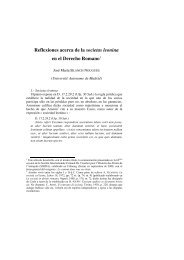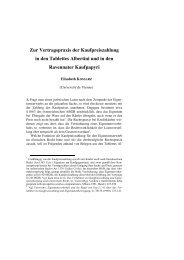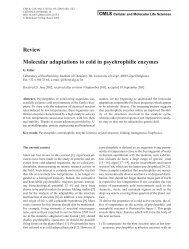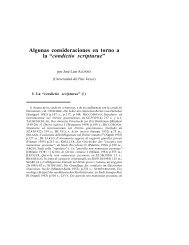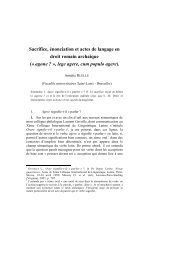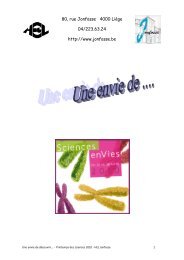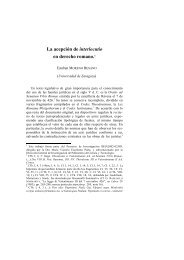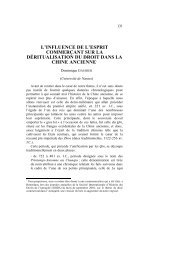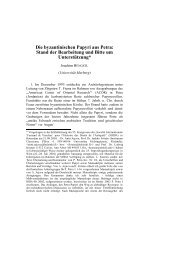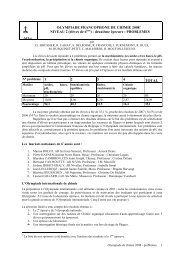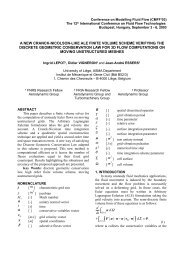The Potnia Theron
The Potnia Theron
The Potnia Theron
Create successful ePaper yourself
Turn your PDF publications into a flip-book with our unique Google optimized e-Paper software.
378 Alison E. BARCLAY<br />
<strong>The</strong> large number of occurrences of the motif on seals, rather than in other media, is<br />
not entirely due to accidents of preservation. <strong>The</strong> “Hero” as Master of Animals does appear<br />
in other media in the third millennium, 33 but despite its potential versatility for use in a wide<br />
variety of media, the composition does not seem to have been commonly used for jewelry,<br />
reliefs, figurines, stone vessels or for decoration on monumental architecture. 34 Nor is there<br />
evidence of use of the Master of Animals in the popular arts. Seals were a major medium for<br />
artistic expression in the Near East and the symmetrical composition is a design that is easily<br />
adapted to the rectangular field of a cylinder seal. But it is those who are commissioning the<br />
seal designs who are important to understanding the function of the motif. Seals were used for<br />
administrative purposes, usually made of precious stones and were high status objects. <strong>The</strong>re is<br />
a clear association between the “Hero” as Master of Animals and royalty, or at least the upper<br />
classes and so, again, an association with power.<br />
When the Mistress of Animals appeared in Near Eastern art, it was as a deity rather than<br />
a female equivalent of the “Hero.” As a deity she may be a symbol of protection on the seals or<br />
pendants, or an object of devotion on the stelae. Which deity she represented is debatable: she<br />
has been identified with Ishtar-Inanna, who was often depicted with a lion; 35 with the Syrian<br />
goddess Anat, who, in the Ugarit texts, is a huntress and warrior; 36 and with Qudshu, the deity<br />
who is identified on the Egyptian stelae. <strong>The</strong> symmetrical scheme has clearly been adapted<br />
for a Syrian goddess from the Master of Animals composition, but whether the Mistress is<br />
a feminization of the Mesopotamian motif in concept as well as composition has yet to be<br />
determined. 37<br />
<strong>The</strong> Aegean<br />
<strong>The</strong> symmetrical composition of the <strong>Potnia</strong> <strong>The</strong>ron first appears in Aegean glyptic art<br />
in LMI. Judging by the extant examples, which are admittedly few in number, the Mistress of<br />
Animals is initially much preferred over the Master (Chart II). She wears Minoan-style dress<br />
and tends to stand with her head and torso facing front, her feet and lower body in profile<br />
and her hands upraised (Pl. CIIIa, CIVe). She occurs in two types of composition – one in<br />
which she “controls” her animals passively, without touching them; the second in which she<br />
subdues the animals through physical force, holding them by a body part. In LMI, the less<br />
aggressive “mastery” of animals is the more common. <strong>The</strong> Mistress is depicted supporting a<br />
“snake frame” above her head, and there is often a double-axe centered between the bows of<br />
the frame (Pl. CIIIa, CIVe). In this variation, although she is accompanied by lions or griffins,<br />
she does not touch them. Two seal impressions from Knossos, on which the Mistress touches<br />
two lions on the chin, may be examples of the second type. 38<br />
33 For example, on two lyre boxes from Tomb of Queen Pu-abi, Royal Tombs of Ur (British Museum WA<br />
1211981 and Philadelphia University Museum U.10556) and on a stone cup from Uruk (British Museum WA<br />
118465). All three examples can be found in COLLON (supra n. 22, 1995) Figures 53, 192 and 36.<br />
34 BARCLAY (supra n. 1) Ch. 1.<br />
35 See WESTENHOLZ (supra n. 17) 72-76, for a study of Inanna-Ishtar.<br />
36 WESTENHOLZ (supra n. 17) 79, DAY (supra n. 29) and CORNELIUS (supra n. 29).<br />
37 WESTENHOLZ (supra n. 17) 79: “Anat in her character of perpetual btlt was forever on the threshold of<br />
adulthood with its defined sexual roles. This lack of complete gender separation was expressed mythologically<br />
by a ‘confusion of categories’, the absence of a boundary between male and female spheres of activity,<br />
leaving her free to participate in the culturally masculine pursuits of warfare and hunting.” This may account<br />
for the adaptation of a predominantly male symbol of power for a female, Syro-Palestinian deity.<br />
38 Knossos seal impressions: HMs 158 + 662. See M.R. POPHAM and M.A.V. GILL, <strong>The</strong> Latest Sealings from<br />
the Palace and Houses at Knossos (1995) 47-48, Pl. 29 #R32. <strong>The</strong> LMI date is taken from J. YOUNGER, “<strong>The</strong><br />
Iconography of Rulership: A Conspectus” in Ruler 183, #204. <strong>The</strong> gold diadem from the Zakros region<br />
noted in Chart II depicts a Mistress of Animals holding goats by their hind legs, the more violent method of<br />
controlling animals that is much more common in LBIII. <strong>The</strong> diadem was a surface find, part of the “Zakros<br />
Treasure” (Archaeological Museum, Herakleion formerly part of the Giamalakis Collection) and so it is not<br />
possible to give it an exact date. Platon suggests that the diadem belongs to the ‘flowering of the palace<br />
period’: N. PLATON, Zakros. <strong>The</strong> Discovery of a Lost Palace of Ancient Crete (1985) 22-23, photo page 11. If this<br />
diadem belongs to LMI, it is the only extant example from this period of a Mistress of Goats and of the more<br />
aggressive method of subduing the animals.



